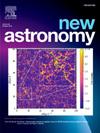The baryonic mass estimates of the Milky Way halo in the form of high-velocity clouds
IF 2.1
4区 物理与天体物理
Q2 ASTRONOMY & ASTROPHYSICS
引用次数: 0
Abstract
The halo of our Galaxy is populated with a significant number of high-velocity clouds (HVCs) moving with a speed up to 500 km/s. It is suggested that these HVCs might contain a non-negligible fraction of the missing baryons. The main aim of the current paper is to estimate the baryonic mass of the Milky Way halo in the form of HVCs in order to constrain a fraction of missing baryons in the form of these clouds. Such findings would give substantial help in the studying halo dynamics of our Galaxy.
We first estimate the HVCs distance. We consider the most recent and updated HVC catalog, namely the Galactic All Sky Survey (GASS), which, however, covers the southern sky declinations, south of . Following a model presented in the literature, we assume that most of the HVCs (not all of the HVCs in the Milky Way) were ejected from the Magellanic Clouds (MCls) which is at a distance of about 50 kpc. We assume that the HVCs have a temperature in the range of about – K, and are distributed in the Galactic halo as the Navarro–Frenk–White (NFW) profile. Since the GASS survey covers a small portion of the sky, we estimate the number of missing clouds by using Monte Carlo (MC) simulations. The next step will be to estimate the total mass of the Milky Way contained in the form of these HVCs. The total mass resulted to be in the form of HVCs and compact high-velocity clouds (CHVCs).
高速云形式的银河系晕的重子质量估算
我们银河系的光环中存在着大量的高速云(HVCs),其运动速度高达每秒 500 公里。有人认为,这些高速云可能包含了不可忽略的一部分缺失重子。本文的主要目的是估算以高速云形式存在的银河光环的重子质量,以确定以这些云的形式存在的部分缺失重子。我们首先估算了HVCs的距离。我们首先估算了HVCs的距离。我们考虑了最新的HVC星表,即银河系全天空巡天(GASS),但它只覆盖了南部天空的偏角,即b≤60∘以南。根据文献中提供的模型,我们假定大部分 HVC(不是银河系中的所有 HVC)都是从麦哲伦云(MCls)中喷出的,麦哲伦云的距离约为 50 kpc。我们假定HVC的温度范围约为102-104 K,并以纳瓦罗-弗伦克-怀特(NFW)剖面的形式分布在银河晕中。由于 GASS 勘测只覆盖了一小部分天空,我们通过蒙特卡罗(Monte Carlo,MC)模拟来估计缺失云的数量。下一步将是估算这些 HVC 所包含的银河系总质量。结果显示,HVC和紧密高速云的总质量为(7±2)×109M⊙。
本文章由计算机程序翻译,如有差异,请以英文原文为准。
求助全文
约1分钟内获得全文
求助全文
来源期刊

New Astronomy
地学天文-天文与天体物理
CiteScore
4.00
自引率
10.00%
发文量
109
审稿时长
13.6 weeks
期刊介绍:
New Astronomy publishes articles in all fields of astronomy and astrophysics, with a particular focus on computational astronomy: mathematical and astronomy techniques and methodology, simulations, modelling and numerical results and computational techniques in instrumentation.
New Astronomy includes full length research articles and review articles. The journal covers solar, stellar, galactic and extragalactic astronomy and astrophysics. It reports on original research in all wavelength bands, ranging from radio to gamma-ray.
 求助内容:
求助内容: 应助结果提醒方式:
应助结果提醒方式:


